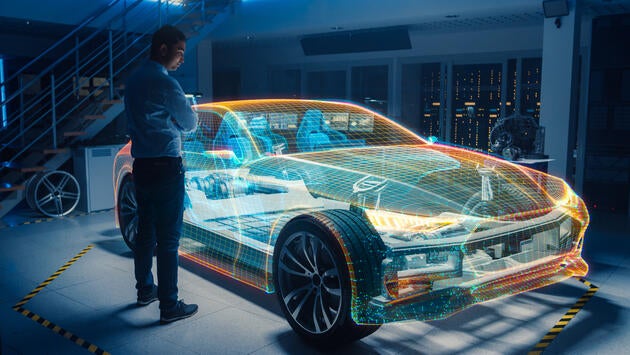
The use of simulation for product development a virtual test environment is becoming increasingly common.
Punch Powertrain applies a range of simulation tools which can augment traditional physical testing methods. This is evident in the testing of new transmissions.
The company points out that testing transmissions can be a complicated business. Transmissions need to align with every other component of a car, while some parts are still in development and not available for testing. Which is where hybrid test beds come in.
Punch Powertrain tests its transmissions in a partly physical, partly virtual set-up, where software simulates certain components. It claims a state-of-the-art technology that allows for quick turn-around and flexibility.
One area where this comes in handy is acoustic testing. Engineers test the shifting noise a transmission makes. That’s something they can start doing even when they don’t have key components, like the engine, yet. Virtually simulating the engine also offers the advantage that there’s less noise from a combustion engine, allowing for better assessment of the transmission noise.
Punch Powertrain can simulate a range of conditions using its software. “We can for example give the car more slope or load, and we can play with the speed and forces,” says Ilyas Barrou, test rig software developer. “It’s like we have a real car on the test bed.”
Simulation is not just limited to the engine. “Before you can test a transmission, you also need to simulate components like the ABS,” says Pepijn Peeters, test rig engineer. “We also simulate the load on the wheels, so the transmission experiences conditions similar to an actual vehicle. We even go so far that if you suddenly accelerate, the test bed will simulate the car pushing, which has a small effect on the transmission.”
Punch Powertrain maintains that its testing capacity is pretty unique. “There are for example only 12 acoustic NDTS test beds like ours in the world, and most of them are in China,” says Peeters.
Safety and speed
Why is this combination of virtual and physical testing so useful? Punch says it is much faster, as engineers don’t need to wait for components that are still under development. But there’s more to hybrid testing than just speed. “You also don’t have fuel lines lying around, which makes it safer,” says Peeters. “Virtual testing is more accurate than using older, non-representative models of certain components. And we can switch easily, allowing us to for example test a transmission with different types of engines.”
“To validate a transmission we need to do many tests,” adds Barrou. “Now we can do that partly using software. We can see how the transmission performs on the highway or in the city. Anything you can do in a real car we can simulate on our test bench.”
Testing hybrids brings new challenges
One of Punch Powertrain’s next engineering challenges is simulating a hybrid car, which is more difficult compared to one with just an internal combustion engine. “A hybrid transmission adds another layer of complexity,” says Peeters. “It’s not just the engine with the ICU and the transmission with a TCU, you also have the e-machine with an MCU and a battery, with an associated management system. On top of that there’s a powertrain control unit, or PCU. So there’s a much larger number of components that need to be simulated.”
Designing a hybrid test bed that can handle this was complicated. It is described by Punch as an important step on the way to making the company ready for the future. “Testing hybrid transmissions is the most complicated testing you can do,” says Peeters. “An EV on the other hand is simpler. So if you know how to simulate a hybrid, you’re ready for EVs.”
The point of all of this testing is to serve Punch Powertrain’s customers in a better way. “It gives a development project the maximum degree of flexibility,” adds Peeters. “We are ready for the future with our new testing rigs. If you compare our company to five years ago, we are taking huge steps.”
Punch Powertrain applies a wide range of simulation tools and methods, that can support the engineers in the design phase and enable to validate the performance of their design, on different levels of complexity and integration, including at vehicle level.
Carrying out simulations and virtual tests on components and complete products enables Punch Powertrain to verify the performance of its products early in the process without any physical production. For this, the company uses commercial software, further complemented by self-developed tools, scripts and processes. These are used to modelize the complete transmission, all the mechanical and electronical parts, as well as the controls side as close to reality as possible. “The programs enable us to examine a wide range of highly detailed aspects of a product,” says Hervé Bratec, Simulation Factory Leader at Punch Powertrain. “Across all possible parameters: performance, driveability, durability, etc. We can predict the fuel consumption, acoustic performance, vibrations, the strength and wear, etc – on both component and transmission level. ”
Reducing test cycle cost by 50%
Compared to physical testing the digital testing environment offers various advantages. Bratec sums up the difference in approach: “Physical tests mostly provide either a fail or pass outcome. To understand why the fail or pass happened or how far a fail was from a pass, in-depth and time consuming analysis is required. With a virtual test, using simulations, that information is available much easier, based on the pre-defined level of accuracy. ”
A second major advantage is the cost, as it eliminates the cost of physical preparations, as well as of production of physical parts and systems in-house or by external parties. Therefore virtual simulations result in a cost reduction to the test cycle estimated at over 50%. “Furthermore, the expedited validation process further benefits our partners in the eco-system, such as component suppliers, enabling them to participate in the development process and to start their tooling build preparations at an earlier stage,” says Bratec . “All steps taken together, digital testing enables us to shorten time to market and expedite product launches.”
Testing prior to engine availability
Punch maintains the benefits to the customer are clear as it can quickly test the interaction between an engine and a gearbox before physical engines and vehicles are available.
Bratec points out the complete engine block can be simulated using its main characteristics, given by the OEM customer. “The car itself is taken into the equation by entering its parameters, such as its weight and tyre dimensions. This makes it possible to calculate, for instance, the transmission’s share in the fuel consumption. By changing the characteristics, we can check how our transmission is performing on different types of cars, such as an SUV, a sedan or a sports car,” he says.
“As part of the transmission’s virtual assembly it can be pre-calibrated virtually: which entails fine tuning the control of the transmission for a specific vehicle. This will enable us to understand the transmission’s reaction with the same engine in different vehicles.”
AI to aid calibration
Going forward artificial intelligence will greatly support pre-calibration, says Bratec. “The AI can help by considering already known data and using it for new car models.
“A pre-calibration with AI could reduce the traditional calibration period of months to only a few weeks, fast tracking the whole process. ”
Physical and digital and ‘best of both worlds’
While offering many advantages, virtual testing is not there to fully replace physical test, Bratec points out. “Both are complementary. Virtual supports physical to select the most appropriate physical tests and it reduces unnecessary time and efforts spent. Physical supports virtual in making it more efficient and providing better results. Their combination offers us the best of both worlds.”

